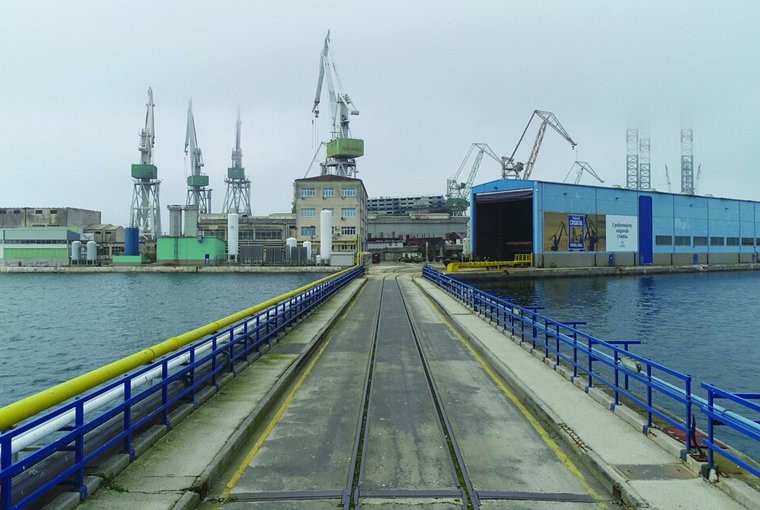
Croatian filmmaker Elvis Lenić bagged the top prize at the Ji.hlava International Documentary Film Festival for his latest work Ship. In the film, Lenić reflects on the decline of the Uljanik shipyard in his hometown Pula, a symbol of both industrial prowess and communal identity. Lenić’s career took him from being a mechanical engineering student to becoming a film journalist and documentary filmmaker. His work at the Uljanik shipyard, coupled with his teaching activity at the Technical School in Pula, underlines his connection to the local community and its industrial heritage.
Lenić´s filmography, though geographically centered in the Istrian region and his hometown of Pula, Croatia, transcends its boundaries to explore themes such as memory, identity, and the flux of cultural transition intertwining the personal and the universal, the past and the present.
The director’s body of work is characterized by a close engagement with the stories and history of his native region. This is exemplified in works like Monologue About Pula (2021), an experimental documentary inspired by Ivan Martinac’s 1961 influential short Monolog On Split. Lenić adapts the premise to Pula, using archival footage from the 70s and 80s to navigate themes of transience and mortality against the Mediterranean backdrop.
In 9th of January (2016), Lenić focuses on a significant but tragic historical event in the Istrian village of Bokordići. The film is an amalgamation of survivor testimonies from the night of 9 January 1944, when fascists assaulted the village. The narrative mosaic ties personal recollections to the broader historical canvas of World War II’s impact on local communities.
Meat (2018) takes a culturally introspective turn, delving into the traditions of pig slaughter in Istria. The documentary juxtaposes age-old practices with modern-day perspectives on politics, ecology, and nutrition, illustrating the evolving cultural landscape of the region. PLUF! (2019) spotlights a unique local competition in Istria that scores the sound of rocks thrown into water, known as “plufism”. Through the odd sport, the director reflects on community, tradition, and the importance of preserving local customs.
A recurrent theme in Lenić’s work is the exploration of personal memory that accumulates into collective local consciousness over time. The director´s films often act as conduits for the histories and experiences of local communities, shedding light on stories and traditions that might otherwise remain obscured.
This focus extends to examining cultural practices and their evolution. Identity, particularly in the context of changing socio-political landscapes, is another significant theme. Lenić’s films capture the essence of Istrian culture while reflecting on how this culture adapts and reacts to broader societal shifts, with the local stories functioning as a pars pro toto of how not only the region but the territory at large is changing.
Lenić’s style is marked by a combination of experimental filmmaking and traditional documentary techniques. Such an approach not only anchors his films in a specific historical context, but also allows for a more abstract exploration of themes as is the case in his latest work.
Ship delves into the history and downfall of the Uljanik shipyard, intertwining the personal history of former workers with that of the shipyard that had employed the director and his family members as well. The documentary portrays the shipyard not just as a physical space, but as an entity integral to the collective identity of Pula.
Golden Age Begone
Through a collage of observational footage from the current state of disarray, Lenić captures the stark contrast between the shipyard’s former glory as it is related by the ex-workers with memories of and emotional ties to Uljanik, and the shipyard´s present state of abandonment. This contrast between the vibrant past and the desolate present serves as a reminder of the impermanence of industrial might and the socio-economic shifts impacting communities globally.
Ship marks yet another addition to Lenić’s ongoing socio-geography of the Istria region with the portrait of the Uljanik enterprise that has shaped Pula for more than 160 years as one of Croatia´s biggest shipyards. The director documents the post-mortem of the Austro-Hungarian shipping empire, which did not manage to survive the transition to capitalism.
The entire film is compiled from footage of the current state of disarray, with Lenić documenting the decay of the giant shipyard as DoP and mapping its lifeless and abandoned corners and niches. The shipyard is a magnificent ruin with some of its recent history visibly imprinted on its architecture. The topographic footage of the shipyard´s area dominated by the gigantic carcass of an unfinished ship as work-in-progress is interspersed with interior shots offering an inside-out scan of the place.
Lenić’s flight through the nooks and crannies of the shipyard creates a non-figurative portrait of an industrial decline (with the sole exception of rare moments when a few workers wander into the frame). At the same time, the shipyard is a monument to a bygone era. The images of a ghost factory with disembodied voice-overs of former workers create a junction of past and present as Lenić constructs a socio-geographical monument through the architecture and the space of the open-air museum that the shipyard has become.
Uljanik played a pivotal role in maritime history, producing over 50 ships for the navy. After World War I, while under Italian control, its focus shifted primarily to ship repairs. The mid-20th century saw a significant transition, with the shipyard being revived as a state-owned entity specializing in commercial cargo ships and tankers. However, the turn of the 21st century brought with it a series of challenges. After its privatization in 2016, the shipyard grappled with labor strikes, order cancellations, and escalating debt.
This downward spiral reached a critical point in 2019 with the arrest of a dozen former employees on fraud charges, culminating in the company’s bankruptcy a mere two months later. At the time of the bankruptcy filing, the shipyard was reported to be employing over 1,400 workers, but had more than $25 million in debt. In July 2023, a third tender for the shipyard failed to attract any bidders. The new minimum bid was set at €13.8 million for the decomposing shipyard, but the government said it would not provide additional support, leaving it unclear what the next steps for the shipyard will be.
Lenić acquired testimonials from the former workers, and organized them in an oral history fashion to create “a narrative arc” tracing the the shipyard´s life in the second half of the 20th century and the early 21st century. As is typical of the territory of Central and Eastern Europe, most precisely of the so-called Communist bloc, the former employees retell how the shipyard that had employed several generations in the family in the region basically became a part of the identity not only of workers but of whole families.
Heritage Enterprise
The workers remember the times when they served at the state-own shipyard as the golden age – there was work for everybody, livable wages, and housing, that is the very benefits that have become the mantra the elder generations pining over the good old Communist times keep repeating, with the memories of the lost living standard seemingly outweighing the cons of the totalitarian regime.
But the happy memories and anecdotes in the testimonies that Lenić procured are soon overshadowed by the looming sense of post-privatization discomfort. The tune is once again a familiar one when it comes to the former Communist countries in Eastern Europe, as the legacy company fails to find a footing in the market economy in private hands. The workers soon begin to display a disdain for the restructuring, or corporatization, of the shipyard, with the number of managers proliferating and the number of workers constantly declining.
Alongside labor cutbacks come wage cuts and ultimately unpaid wages, which soon causes strikes. Lenić never inserts archival footage, instead committing to the filming of shipyard spaces in their current state, all the while matching the narrative in the testimonials with shots of particular spaces in the shipyard. When one worker recalls a fire in a workshop, Lenić cuts to the particular workshop where it broke out, which shows clear signs of both the fire and the extinguishing operation. For the more emotional moments, the director utilizes archival soundbites, which are taken from the news and from recordings of the protesting mob during the strikes. Throughout the film, voice-overs and the soundscape more generally are the driving plot device of Ship.
The decision not to budge but to keep the current state of the shipyard on screen instead of resorting to archival footage, provides the counterpoint to all that is being recounted by former workers, good and bad, high and low. As the footage produced for the film reveals, the history of the shipyard will ultimately culminate in ruin. Despite this grim outlook for the place that Lenić has been so attached to, the film does not provoke a sense of doom and gloom, instead opting to document the developments with a dry matter-of-factness.
At times, the style adopted by the director behind the camera resembles a wildlife photographer more than it does a forensic photographer. While the giant post-industrial rigor mortis Uljanik has become is hard to overlook, Lenić captures the waves splashing against the buildings and the birds flying around the spaces in a lively and colorful portrait instead of dwelling on the capitalist trainwreck that displaced locals and subverted their local patriotic pride.
Ship is a documentary as if taken out of a family album of communal identity. It preserves a space that encapsulates big history on a small scale, wherein a local patriotic heritage becomes a bittersweet legacy. The accumulation of personal stories becomes a homage to a place built by people. The film also manages to address larger topics across the socio- and politico-economic lines of a class struggle and the mishandling of the industry, most likely not accidental, by elites. While the memories of a fading era and the individual experiences attached to it remain crucial to The Ship, it is hard to overlook the film’s connection to the current political climate.




Leave a Comment